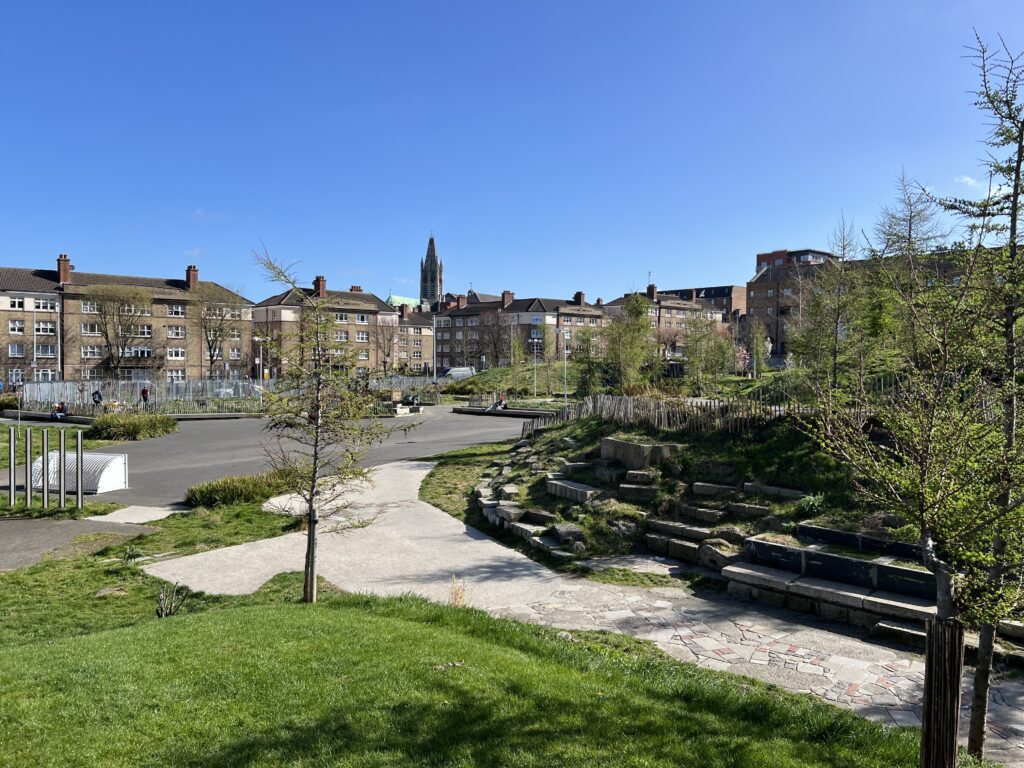A homeless person is more likely to die prematurely, and people are less likely to know about it
By Julia Danilowa
A large Garda presence was spotted in Bridgefoot Street Park, just off the quays in Dublin 8, early one morning at the beginning of the month. Witnesses saw what seemed to be a covered body and stated that access to parts of the park was restricted.
Most of the area remained accessible throughout the incident indicating that no violent crime took place. No ambulance arrived on the scene. Within a few hours all parts of the park were again opened to visitors and no further Garda presence was seen that day.
Bridgefoot Street Park is close to social housing, multiple homeless charity services and several emergency accommodation hostels. The area is frequented by rough sleepers.

An Garda Síochána did not issue a statement regarding the incident. No further information outside of the witness accounts has been made available to the public at large nor the homeless community in Dublin 8.
The event illustrates a larger trend in how the health and wellbeing of homeless people in Ireland is handled generally and specifically how information surrounding the deaths of homeless people is treated.
The homelessness crisis in Ireland remains uniquely severe despite the levels of homelessness rising across Europe. The number of people in Ireland experiencing homelessness has more than doubled over the last decade and continues to rise. As of February 2025, there are 15,378 homeless people accessing emergency accommodation, of which 4,653 are children. In the month before the eviction ban was lifted, January 2023, there were 11,754 people in homeless services in Ireland.
These numbers do not include ‘hidden homelessness’ adults and children staying in domestic violence refuges, sleeping in cars, couch surfing with friends and relatives, or living in unsafe and unstable accommodations. A 2022 poll by the Simon Community showed nine per cent of people had friends affected by hidden homelessness in the past 12 months.
The Simon Community Official Winter Count of people sleeping rough shows that at least 134 people were sleeping outside over the week of 4 to 10 November 2024 in Dublin alone. Furthermore, many adults using emergency accommodation still occasionally sleep rough due to a lack of beds, difficulties travelling, and conflicts in hostels with staff or other service users.
The Health Research Board (HRB) recorded 84 premature deaths among the homeless population in Ireland in 2019. In 2020 the figure rose to 121. 115 people died in Dublin in 2021. In 2022 the number of deaths fluctuates between 47 and 95.
Despite these solid figures, further information about the deaths among the Irish homeless population is scarce. After 2022 no official data have been published. In both 2023 and 2024 only incomplete monthly data were made available for Dublin. There, twenty homeless people died in the first four months of 2023, among them a 17-year-old boy. 40 deaths were recorded in 2024 up to the month of October. There are no national figures available after 2020 and no further HRB studies have been published.
Few of the deaths among people experiencing homelessness in Ireland are publicly acknowledged by officials. Furthermore, people who are homeless often have difficulties getting information about their potentially deceased friends and community members. Some report that gardaí can be dismissive, especially towards the concerns of people who are sleeping rough.
The 2020 HRB report showed that many of those who died while homeless tended to be significantly younger than those dyingin the wider population. Half of the men were aged 42 years or younger at the time of death and half of the women were 36.5 years or younger. Almost all who died had a history of substance abuse, however below half had ever received treatment. 46.3% of the deceased had a history of mental health issues.
Research by the UCD School of Public Health shows that experiencing homelessness increases the risk of illicit drug use, self-harm behaviour and visits to the emergency departments. At the same time, access to GP health services is limited.
The findings suggest that there are not enough programmes for harm reduction, mental-health support, general healthcare access and care for frequent emergency department attenders. This increases the risk of premature death.
These issues present in addition the inherent increased danger of exposure to the elements as well the inherent stress and trauma of homelessness.
Authorities try to limit extreme weather exposure yearly. 400 additional cold weather beds were made available by the Dublin City Council in the winter of 2024 to 2025, 70 more beds than the year before. However, due to the quality and accessibility of the accommodations, some of those sleeping rough can choose to remain outside. Many have traumas associated with hostels, most hostels are not equipped to take care of service users’ mental health conditions and concerns. Furthermore, some individuals do not want to be separated from their communities, families or partners and so feel safer remaining outside despite weather conditions.
Homeless people in Ireland experience increased health and safety risks, yet information about risks, supports, services and deaths in the community remain limited and inaccessible to both the wider public and the homeless population. A homeless person is more likely to die prematurely, and people are less likely to know about it.